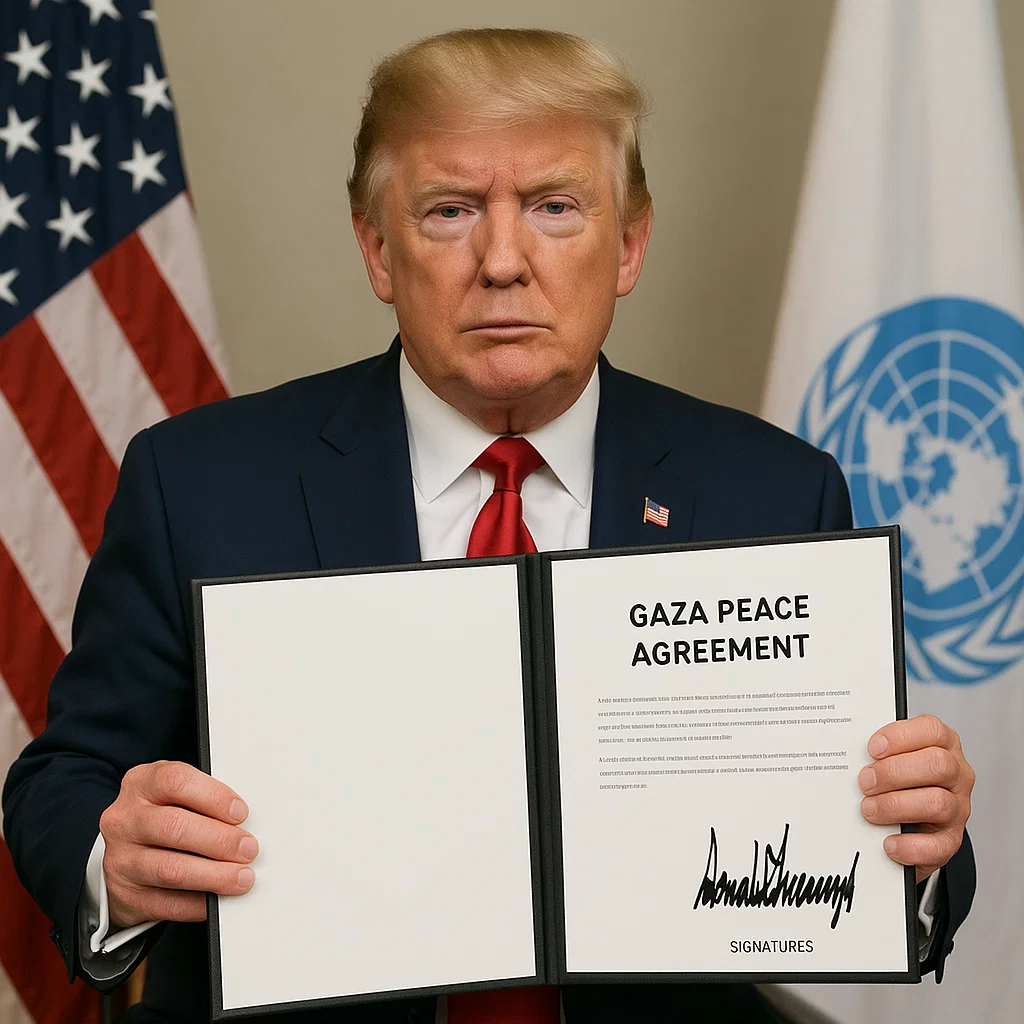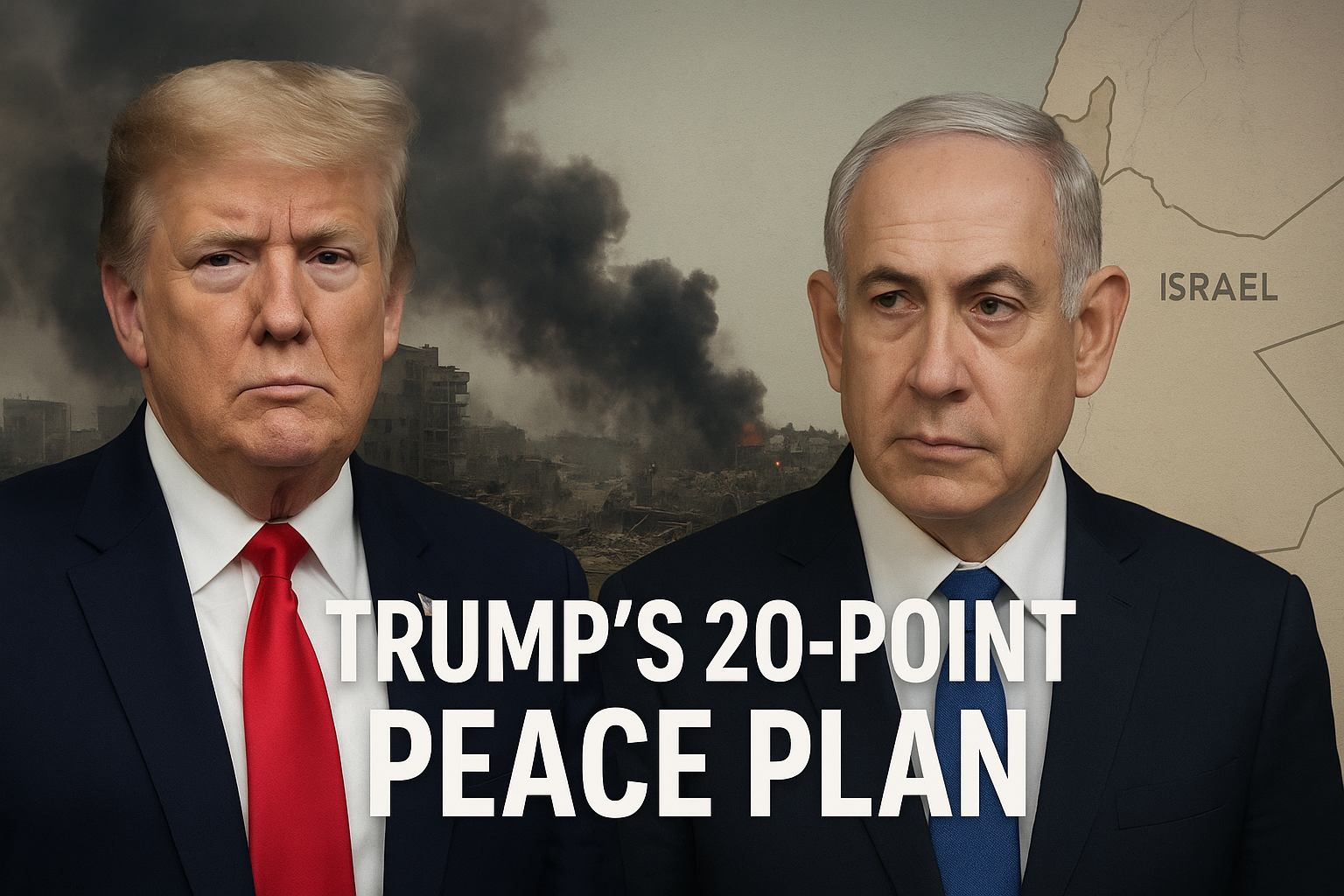The Gaza war has raged with devastating human and political consequences, leaving the region scarred and the global community desperate for a breakthrough. Into this storm steps Donald Trump, unveiling what he calls a 20-point peace plan for Gaza — a sweeping attempt to reset the conflict’s trajectory. Unlike earlier efforts that often stalled on vague commitments, Trump’s proposal is detailed, transactional, and unapologetically blunt.
The plan blends hard security guarantees with economic promises, offering carrots and sticks to both sides. It insists on the release of all hostages and prisoners, a phased disarmament of Hamas, and a massive international humanitarian and reconstruction initiative. At the same time, it sets out pathways for Palestinian self-governance under strict oversight and aims to bind Arab neighbors into a security and funding framework.
Trump’s peace blueprint is not just about Gaza. It is also a message to the world: that the U.S. under his leadership can still shape outcomes in the Middle East, even when traditional allies like Europe are charting independent courses, and when regional powers are skeptical of Washington’s motives.
Yet the plan faces monumental obstacles. Israeli mistrust of external guarantees, Hamas’s reluctance to surrender arms, and Palestinian demands for sovereignty rather than conditional autonomy could all derail implementation. Furthermore, critics argue that the plan is designed more for global headlines and domestic political gain than for durable peace.
Still, by tabling a comprehensive 20-point roadmap at this moment of deep fracture, Trump has forced the conversation to shift from endless war to possible peace. Whether this blueprint becomes the foundation of a new regional order — or collapses into another failed proposal — will shape the Middle East for years to come.
This article breaks down the 20 points of the Gaza peace deal, examines what’s at stake, and explores whether this plan can actually bring stability to the region.
What the Plan Proposes — Key Elements
- Ceasefire & Hostage Return
Once Israel publicly agrees, all hostages (both living and deceased) will be returned within 72 hours. Hostage release is a central early trigger. - Staged Israeli Withdrawal & Freeze of Military Operations
Israeli forces would begin withdrawing to a pre-agreed line to facilitate the hostage release. During that period, all military operations (air, artillery, etc.) are to pause and battle lines frozen. These conditions precede a complete, step-by-step withdrawal. - Prisoner Exchanges
In return, Israel would release large numbers of Palestinian prisoners: life-sentence prisoners plus those detained since October 7, 2023. There is also a clause that for every deceased Israeli hostage, Israel would release the remains of 15 deceased Gazans. - Demilitarization of Gaza & Disarming Hamas
The plan demands that Hamas dismantle offensive capabilities and stop governing Gaza. Militants who renounce violence could receive amnesty; those wishing to leave would be granted safe passage. - No Forced Displacement / Right of Return
The proposal emphasizes that no one will be forced to leave Gaza, and anyone who leaves should have the right to return once conditions allow. - Humanitarian Aid & Infrastructure Rehabilitation
Massive aid influx via UN and other neutral bodies; restoration of water, electricity, hospitals; removal of rubble; opening of roads; rebuilding basics like bakeries. Aid commitments are to match or exceed previously agreed levels. - Technocratic, Interim Governance
While Gaza is being stabilized, there will be a temporary apolitical committee (technocrats rather than politicians) handling municipal services and daily governance. This would later be overseen by an international body called the “Board of Peace,” reportedly led by Trump and with participation from figures like Tony Blair. - Security & Stabilization Force
A vetted Palestinian police force will be trained; cooperation with Israel and neighboring states (Egypt, Jordan) to control border zones and prevent rearmament / smuggling; provision for a stabilization (or peacekeeping) force under international oversight. - Economic Recovery & Special Economic Zone
Creation of an economic development plan, possibly a special economic zone (SEZ) with preferential access, reduced tariffs, investment incentives to rebuild Gaza and generate jobs. - Pathway to Palestinian Self-Determination, Conditional
The plan includes vague references to eventual Palestinian self-determination, but only after PA reforms, mindset changes, and depending on how well the transitional governance and security stipulations are met. Statehood is not guaranteed upfront.
What Is Not (or Weakly) Covered
- Hamas’s Agreement Is Pending
Israel has approved the plan, but Hamas has not yet agreed. The plan’s success depends critically on Hamas’s acceptance, which may be hard given several deal clauses. - Detailed Timeline & Verification Mechanisms
The plan doesn’t specify robust verification/truth mechanisms for ensuring that both sides comply — e.g. how to monitor disarmament, manage the role of border controls or define “clean zones.” The plan refers to international oversight, but many details are left vague. - Palestinian Statehood is Conditional and Deferred
The pathway to statehood is contingent, not assured. Many Palestinians and regional actors might see this as delaying or undermining their political aspirations. - Role and Fate of Hamas
The plan bars Hamas from governance. But whether and how that transition of power happens, who enforces it, and how to avoid collapse or chaos, are major open questions. Also, how communities aligned with or reliant on Hamas services will fare is unclear.
Strategic Implications — Deep Dive Analysis
Pros:
- Clarity of structure and incentives. The plan ties concrete actions (hostage return, prisoner exchange, aid flow) to visible, time-bound steps. That clarity helps reduce uncertainty, potentially making the deal more acceptable to external mediators and Arab states.
- International involvement may lend credibility. With oversight by UN agencies and other neutral parties to manage aid, governance, and borders, there is a possibility for greater accountability — assuming institutions function well.
- Potentially end to hostilities if conditions met. If Israel, Israel’s partners, and Hamas accept the plan, these provisions could substantially reduce violence, restore basic living conditions, and open a pathway toward rebuilding.
Cons / Risks:
- Hamas’s acceptance is deeply uncertain. Some conditions (disarmament, loss of governance) are likely red lines for Hamas, which has historically refused to cede control.
- Enforcement and verification are weak. How will powerful actors ensure Hamas cannot rearm? Who guarantees that prisoner exchanges happen as promised? What prevents Israel from shifting boundaries or reinterpreting “deradicalization”?
- Humanitarian vs political trade-offs. Aid flow and reconstruction depend on political compliance. If conditions become too strict, population suffering may continue while political deliverables lag.
- Possibility of fragmentation. If parts of Gaza are stabilized while others are not, or if authority is split (Hamas, technocratic bodies, local actors), governance challenges and lawlessness may emerge.
- International legitimacy concerns. The plan’s conditionality on PA reforms, the role of an international “Board of Peace” led by external actors, and the sidelining of Hamas may be viewed by many Palestinians (and international actors) as undermining Palestinian agency. That could foster resentment or resistance, making long-term peace difficult.
Hamas, Trust, and the Illusion of Peace: A Tactical Game?
The very idea that Hamas would trust Israel seems contradictory, given decades of blockades, wars, assassinations of its leaders, and systemic denial of Palestinian sovereignty. Yet in the wake of Trump’s 20-point peace plan for Gaza, some reports suggest Hamas might be open to negotiations — if only as a way to relieve immediate suffering in Gaza. But is this genuine trust, or is it a survival tactic manipulated by greater powers?
1. Hamas’s Calculus: Survival Over Trust
Hamas does not fundamentally “trust” Israel; what it seeks is breathing space. After months of bombardment, humanitarian collapse, and international isolation, the group may see temporary concessions (like humanitarian aid corridors or prisoner exchanges) as vital to survival. History shows Hamas has engaged in short-term truces (hudna) not as a step toward peace, but as a strategy to regroup.
2. Israel’s Calculus: Pressure Management
For Israel, entertaining talks with Hamas — even indirectly — may be less about peace and more about managing world opinion. Global outrage over civilian casualties has reached new highs, and even close allies in Europe have begun recognizing Palestine as a state. By appearing to “negotiate,” Israel can diffuse diplomatic pressure without making meaningful concessions on sovereignty or settlements.
3. The American Factor: A Geopolitical Reset
Washington, particularly under Trump, frames any such negotiation as a U.S.-led breakthrough. For America, forcing Hamas to the table under an Israeli security umbrella allows Washington to claim ownership of progress, even if the reality on the ground changes little. It helps redirect global narratives away from accusations of U.S. complicity in Gaza’s destruction.
4. Is This a Game of Smoke and Mirrors?
Critics argue the current momentum is not about resolving the conflict, but about buying time. The U.S. needs to show it is not blind to global outrage; Israel needs to quiet international criticism; Hamas needs a pause to survive. Trust is not the driver here — mutual desperation and optics are.
What Might Happen Next — Scenarios
- Acceptance and Partial Implementation
If Hamas agrees under mediation pressure (from Qatar, Egypt, etc.), one could see rapid hostage release, cessation of large-scale Israeli operations, and visible aid flows. Transitional governance may begin, and rebuilding efforts could scale up. In this scenario, the plan tests its own durability, with checkpoints for compliance that incentivize both sides. - Rejection or Delay by Hamas
If Hamas rejects key clauses (disarmament, loss of political power), the plan may stall or collapse. Israel might respond with resumed military operations. U.S. and Arab mediators may impose diplomatic and economic pressure, but without participatory buy-in, risk remains of escalation. - Partial Compliance with Coercive Pressure
Some parts of the plan may be adopted under duress: Hamas may hand over some hostages but refuse to give up full political control; Israel may pause operations but keep certain military operations. This could lead to friction, localized ceasefires, but no full peace. - Long-term Status Quo Continuation under New Framing
Even if the plan fails, the public existence of the framework—and the discussions around reconstruction, aid, and governance—will shift the narrative. Israel, U.S., and Arab states may keep pressing for parts of the plan as leverage. Gaza’s rebuilding will remain on the international agenda. Diplomatic pressure might increase over time, possible compromises may emerge.
Conclusion & Critical Take
Trump’s 20-point peace plan in Gaza is ambitious, structured, and has elements aimed at reconciling humanitarian urgency with political realities. It represents a clear shift in tone: demanding accountability from Hamas, promising reconstruction, but equally demanding political and security concessions.
Yet its success depends heavily on two fragile variables: Hamas’s willingness to agree to conditionally give up power, and external actors’ capacity to monitor and enforce both sides’ compliance. Without these, the plan risks becoming another blueprint that looks good on paper, moves some hostages, but fails to resolve underlying political grievances and structural power asymmetries.
For the people of Gaza, partial implementation could bring relief; for regional stability, a successful deal would reduce risks of further escalation; for Israel, it would bring security assurances; for the U.S., it is a chance to re-establish diplomatic leadership. But none of that will be permanent unless the plan addresses the deeper questions of governance, justice, and political legitimacy alongside reconstruction.








